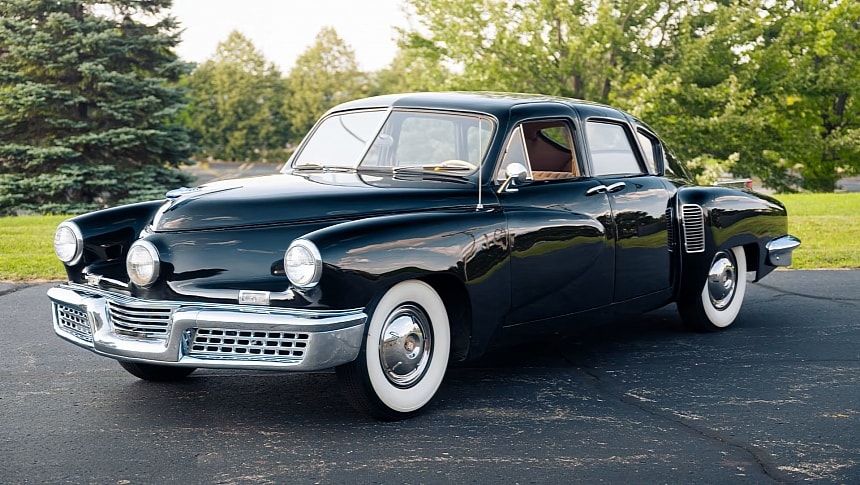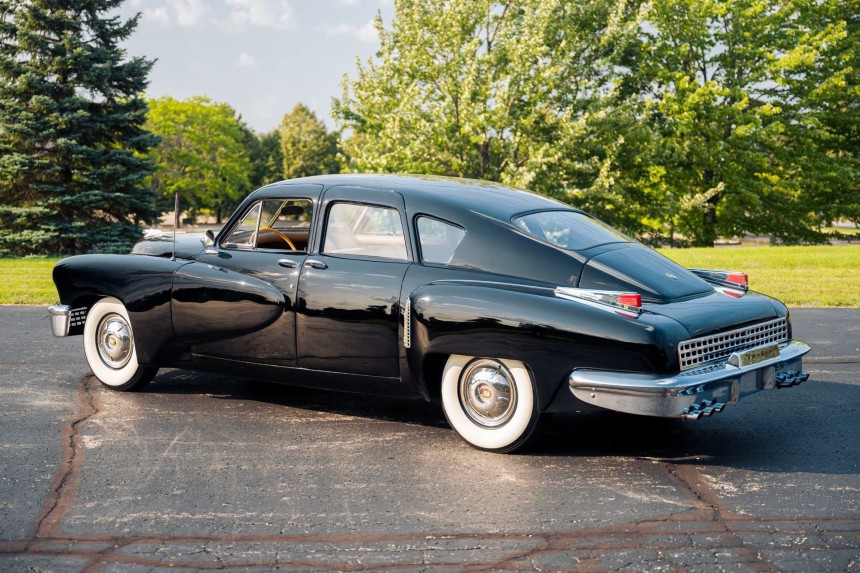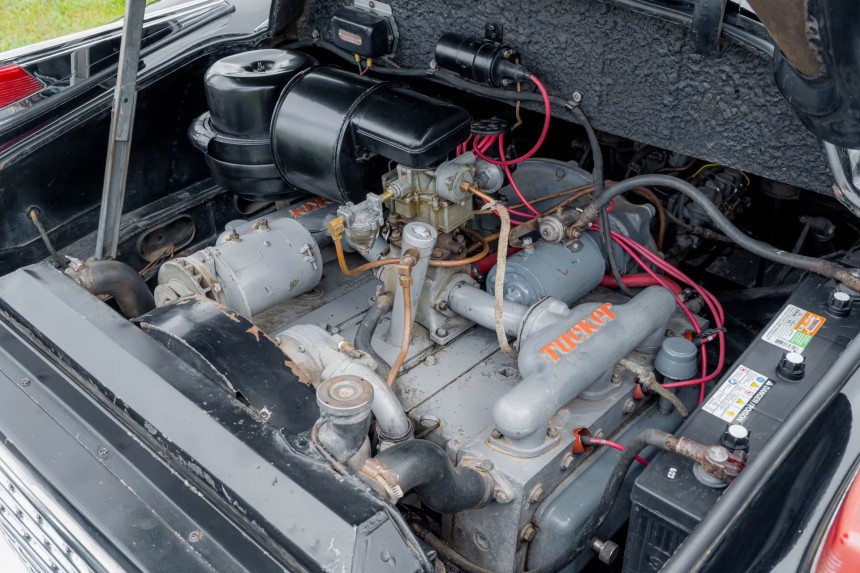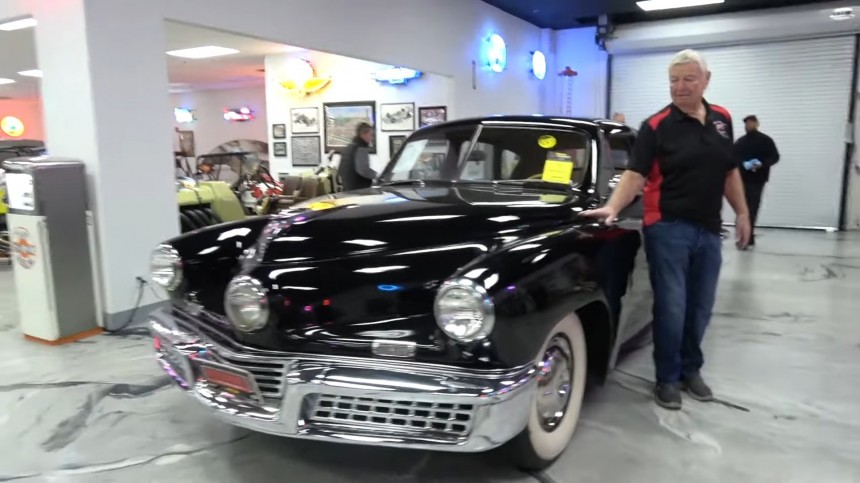Among the piston-abundant landscape of America, few names would spark more interest and controversy than Tucker Corporation. The company’s meteoric passing through the motoring universe was debated for nearly eight decades. The very limited number of automobiles it produced in its three-year existence is one of the greatest legacies of carmaking in America's post-war period.
In 1946, immediately following the return of the entire auto industry to regular civilian market production, Preston Tucker founded a car company and promised a revolutionary automobile. ‘The first completely new car in fifty years’ was a bold statement, but facts backed it. A flat-six engine mounted in the rear, over the driving axle, a four-speed manual gearbox with a column matchbox-sized shifter gate; independent four-wheel suspension, unheard-of safety features, a cornering light at the nose, and many other goodies – the Tucker was on to something.
And that was in 1948 when America was still getting refurbished pre-war designs – it probably didn’t look very well for some of the big players in the industry. The history is riddled with conspiracy theories and partisan assumptions, but the reality is that, by March 1949, the Tucker Corporation folded.
It left behind 51 Tucker 48 automobiles, each a masterpiece of engineering and design, and 47 are documented to have survived. To say they’re rare would be a downright offense to the nameplate. They’re in high demand among the oldtimer collectors’ society – the highest-selling value of one (chassis 1043) was $2.9 million twelve years ago.
Another one – even rarer than the above example – was recently bought by the Martin Auto Museum in Glendale, Arizona, for $1.7 million. The owner of the museum (and of the elusive car) is Mel Martin, the man smiling in the video below when taking delivery of the striking automobile.
The fastback design makes the car appear even sleeker and lower than it already is (with a drag index of 0.27 and five feet from ground to roof – 1.5 meters!); the neat machine was the epitome of engineering. The rear-mounted engine – an aluminum-alloy horizontally opposed six-cylinder powerplant developed for helicopters – was groundbreaking for American motoring stereotypes.
The architecture wasn’t new to the piston universe – Volkswagen and Tatra were strong advocates for it in Europe – but America hadn’t seen it in mass-produces form in any of its domestic nameplates. The aircraft powerplant was converted to water-cooling, and the 335-cubic-inch displacement (5.5 liters) was good for 166 hp and 372 lb-ft of torque. That’s 168 PS and 504 Nm in 1948! For comparison, a Ford V8 made 100 hp in the same year.
The car could cruise at 100 mph (161 kph) and offered ample accommodation for six passengers (think 64-inch bench seats - 1.6 meters). The interior A crash board cowl and a safety chamber were the most advanced safety-related specs of the Tucker. The brochure advised front occupants – driver and passengers – to tuck under the sponge rubber-covered dash in case of ‘impeding collision.’ The tapered frame was designed to deflect an oncoming obstacle in case of a crash, and the ‘Cyclops Eye’ third headlight was another never-before-seen contraption among other American automotive offers.
The lamp – located between the regular lights – would turn in sync with the steering wheel and switch on only at a steering angle greater than ten degrees, left or right. The windshield was made from laminated glass and could be pushed off its frame with a strong blow from the inside, virtually eliminating the most common injuries related to car accidents of the era: deep cuts and cracked skulls. It may sound morbid today, but in 1948, that was cutting-edge tech (no offensive pun intended). Similarly, the side glass was also developed to break into pieces without shards and sharp edges.
The example featured in Lou Costabile’s video is a significant example of the limited batch of 51 units (not that the others would be of a lesser condition). It was used in the Francis Ford Coppola biopic ‘Tucker: The Man and His Dream’ from 1988. Before filming, the car was repainted – the only time in its 76-year existence – but retains the original engine (which runs great; hear it in the video) and Cord electric-vacuum actuated transmission.
The black car (one of four painted in this color from the factory) had three owners before it was bought in January at the Glendale auction. The original buyer (a Tucker dealer from California) kept the rarity for 18 years, then sold it. The new owner (another Tucker loyalist) enjoyed the fabulous machine for 56 years, between 1967 and 2023. His family sold it in 2023 after the collector passed away.
In the late '60s, the car’s suspension was changed from the original Torsilastic rubber system (a Tucker patent) to more easy-to-maintain coil springs (the original suspension wasn’t reproduced back then). The motor has a replacement water pump and a rebuilt ignition distributor and shows 35,576 miles on the odometer (57,242 kilometers).
The engine was rated for 1,500 hours of service life in its aviation applications. Preston Tucker claimed these flat-sixes would last 150,000 miles (241,000 kilometers) under civilian (and civilized) road usage. Again, that was 1948, when the average life of a motor was less than half that number. Play the second video and see more details about that intriguing flat-six.
The story of Tucker Corporation remains a dark spot on the record of American motoring, with the innovative carmaker being accused of fraud, sent to court, and ultimately forced into bankruptcy. Despite being acquitted of all charges, Preston Tucker never recovered, and the fantastic automobile went as fast as it appeared. The remaining examples are just as many testaments of how a great idea can get killed off by bureaucracy, government interventions, and sheer ignorance (or maybe something deeper than that).
And that was in 1948 when America was still getting refurbished pre-war designs – it probably didn’t look very well for some of the big players in the industry. The history is riddled with conspiracy theories and partisan assumptions, but the reality is that, by March 1949, the Tucker Corporation folded.
It left behind 51 Tucker 48 automobiles, each a masterpiece of engineering and design, and 47 are documented to have survived. To say they’re rare would be a downright offense to the nameplate. They’re in high demand among the oldtimer collectors’ society – the highest-selling value of one (chassis 1043) was $2.9 million twelve years ago.
The fastback design makes the car appear even sleeker and lower than it already is (with a drag index of 0.27 and five feet from ground to roof – 1.5 meters!); the neat machine was the epitome of engineering. The rear-mounted engine – an aluminum-alloy horizontally opposed six-cylinder powerplant developed for helicopters – was groundbreaking for American motoring stereotypes.
The architecture wasn’t new to the piston universe – Volkswagen and Tatra were strong advocates for it in Europe – but America hadn’t seen it in mass-produces form in any of its domestic nameplates. The aircraft powerplant was converted to water-cooling, and the 335-cubic-inch displacement (5.5 liters) was good for 166 hp and 372 lb-ft of torque. That’s 168 PS and 504 Nm in 1948! For comparison, a Ford V8 made 100 hp in the same year.
The lamp – located between the regular lights – would turn in sync with the steering wheel and switch on only at a steering angle greater than ten degrees, left or right. The windshield was made from laminated glass and could be pushed off its frame with a strong blow from the inside, virtually eliminating the most common injuries related to car accidents of the era: deep cuts and cracked skulls. It may sound morbid today, but in 1948, that was cutting-edge tech (no offensive pun intended). Similarly, the side glass was also developed to break into pieces without shards and sharp edges.
The example featured in Lou Costabile’s video is a significant example of the limited batch of 51 units (not that the others would be of a lesser condition). It was used in the Francis Ford Coppola biopic ‘Tucker: The Man and His Dream’ from 1988. Before filming, the car was repainted – the only time in its 76-year existence – but retains the original engine (which runs great; hear it in the video) and Cord electric-vacuum actuated transmission.
In the late '60s, the car’s suspension was changed from the original Torsilastic rubber system (a Tucker patent) to more easy-to-maintain coil springs (the original suspension wasn’t reproduced back then). The motor has a replacement water pump and a rebuilt ignition distributor and shows 35,576 miles on the odometer (57,242 kilometers).
The engine was rated for 1,500 hours of service life in its aviation applications. Preston Tucker claimed these flat-sixes would last 150,000 miles (241,000 kilometers) under civilian (and civilized) road usage. Again, that was 1948, when the average life of a motor was less than half that number. Play the second video and see more details about that intriguing flat-six.
The story of Tucker Corporation remains a dark spot on the record of American motoring, with the innovative carmaker being accused of fraud, sent to court, and ultimately forced into bankruptcy. Despite being acquitted of all charges, Preston Tucker never recovered, and the fantastic automobile went as fast as it appeared. The remaining examples are just as many testaments of how a great idea can get killed off by bureaucracy, government interventions, and sheer ignorance (or maybe something deeper than that).















































